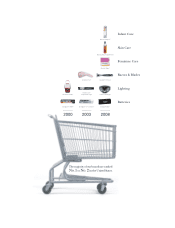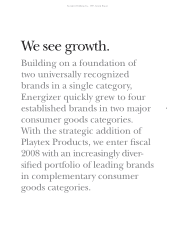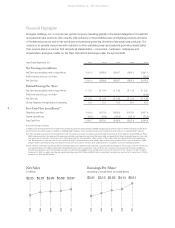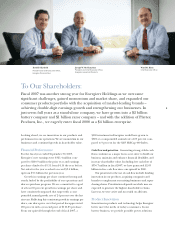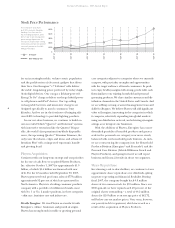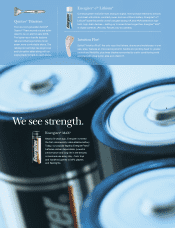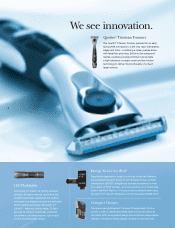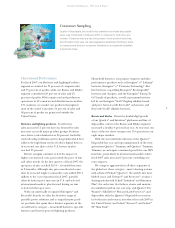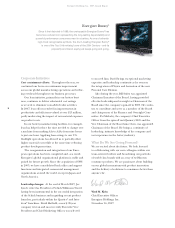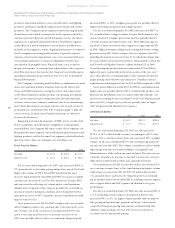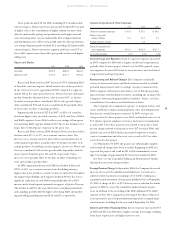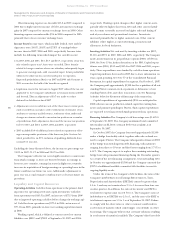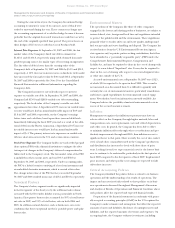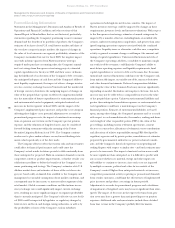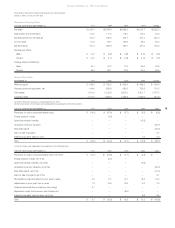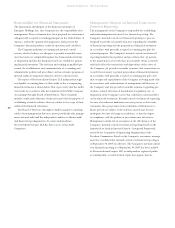Energizer 2007 Annual Report Download - page 12
Download and view the complete annual report
Please find page 12 of the 2007 Energizer annual report below. You can navigate through the pages in the report by either clicking on the pages listed below, or by using the keyword search tool below to find specific information within the annual report.
10
Energizer Holdings, Inc. 2007 Annual Report
The following discussion is a summary of the key factors management
considers necessary in reviewing Energizer Holdings, Inc.’s (the
Company) historical basis results of operations, operating segment
results, and liquidity and capital resources. The Company includes
the battery business (Energizer) and the razors and blades business
(Schick-Wilkinson Sword, or SWS). This discussion should be read
in conjunction with the Consolidated Financial Statements and
related notes.
Battery Business Overview
Energizer is one of the world’s largest manufacturers and marketers
of batteries and flashlights competing primarily in the retail battery
category. We define the retail battery category as household batteries
(alkaline, carbon zinc, lithium and rechargeable) and specialty
batteries (miniature and photo). We market a complete line of
household batteries with two primary brands, Energizer and Eveready,
which are well known throughout the world.
Alkaline batteries are the predominant household battery chem-
istry in developed parts of the world, while carbon zinc batteries
continue to play a significant role in less developed countries
throughout the world. Recently, higher power, higher priced lithium
and rechargeable batteries have grown significantly in response to
more demanding power needs of more advanced devices such as
digital cameras. We use our full portfolio of products and brands to
meet consumer and retail customer needs and to maintain and
enhance our position across the varied markets of the world. Our
presence outside the United States (U.S.) runs from highly devel-
oped economic markets to emerging markets with lower per capita
income. Our portfolio of products allows us to compete in low price
markets and take advantage of trading consumers up to higher per-
forming products as the macroeconomic trends improve.
Energizer operates 19 manufacturing and packaging facilities in
12 countries on four continents. Its products are marketed and sold
in more than 165 countries, primarily through a direct sales force,
and also through distributors and wholesalers.
In the U.S., the battery category is highly competitive as brands
compete for consumer acceptance and retail shelf space. Unit growth
has been positive for many years, but moderated in 2007, partially
due to lower hurricane-related activity. Category value has grown in
recent years as consumers trade up to higher performing batteries,
and due to price increases in 2006 and 2007 in response to rising
material costs. Overall category value has been negatively impacted in
recent years by consumer purchases shifting to larger package sizes
which sell at lower per unit prices. This impact was less pronounced
in 2007 as compared to the previous two fiscal years, and it is difficult
to predict what impact, if any, package size mix will have in
the future.
Energizer is well positioned to meet the needs of customer and
consumer demands, leveraging category expertise, retail understand-
ing and its portfolio of products to give Energizer a strong presence
across the retail channels. Energizer estimates its share of the total
U.S. retail battery category was approximately 39% in 2007, 37% in
2006 and 36% in 2005.
Internationally, the battery category is also extremely competitive,
with Energizer and its competitors fighting for distribution and shelf
space. Unit volume growth is strongest in developing markets and
more modest in developed markets. Pricing increases in response to
rising material costs have occurred in a number of markets, but have
also lagged in areas where competitive pressures are the greatest. As
in the U.S., consumer purchases internationally have begun to shift
to larger pack sizes which sell at lower per unit prices, particularly in
2007. It is unclear how significant this package size mix will be in the
future. The U.S. dollar has weakened against most major currencies
over the last year, improving international results in U.S. dollar terms.
A significant portion of Energizer’s product cost is more closely tied
to the U.S. dollar than to the local currencies in which the product is
sold. As such, currencies strengthening relative to the U.S. dollar
improve margins as product costs in local currency terms decline.
Conversely, weakening currencies relative to the U.S. dollar can be
significantly unfavorable unless mitigated through pricing actions.
Changes in the value of local currencies will continue to impact seg-
ment profitability in the future. At mid-November 2007 levels, overall
currency translation is favorable compared to average 2007 rates.
Razors and Blades Business Overview
SWS is the second largest manufacturer and marketer of men’s and
women’s wet shave products in the world. SWS operates four manu-
facturing facilities worldwide and its products are sold in more than
135 countries. Its primary markets are the U.S., Canada, Japan and
the larger countries of Western Europe. SWS estimates its overall
share of the wet shave category for these major markets at approxi-
mately 20% in 2007 and 21% in 2006 and 2005 with men’s shaving
systems accounting for the decline in 2007.
Globally, SWS products hold the number two market position in
the wet shave products category, with one competitor accounting for
a substantial majority of global wet shave sales. All other competitors
constitute a small minority of category sales. Category blade unit con-
sumption has been relatively flat for a number of years. However,
product innovations and corresponding increased per unit prices
have accounted for category growth. The category is extremely
competitive with competitors vying for consumer loyalty and retail
shelf space.
A significant portion of product cost is closely tied to the U.S.
dollar and the euro. As such, SWS results are highly sensitive to fluc-
tuations in other currencies, particularly the Japanese yen, where
much of its products are sold. Strengthening of currencies compared
to the U.S. dollar, and to a lesser extent the euro, improves margins
while declines in such currency values reduce margins. At mid-
November 2007 levels, currency translation is favorable to SWS
compared to average 2007 rates.
Acquisition of Playtex Products, Inc. (Playtex)
On October 1, 2007, the Company paid approximately $1,900 for the
acquisition of all outstanding Playtex common stock, repayment or
defeasance of outstanding Playtex debt, and other transaction costs.
Playtex operates eight manufacturing and packaging facilities in the
Management’s Discussion and Analysis of Results of Operations and Financial Condition
(Dollars in millions, except per share and percentage data)


